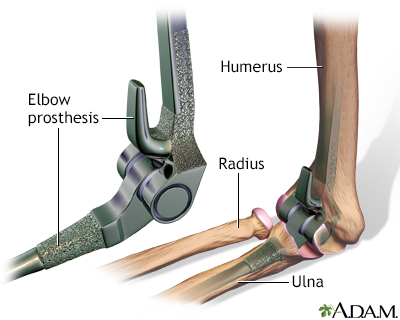Elbow Replacement
Total elbow arthroplasty; Endoprosthetic elbow replacement; Arthritis – elbow arthroplasty; Osteoarthritis – elbow arthroplasty; Degenerative arthritis – elbow arthroplasty; DJD – elbow arthroplasty
The elbow joint connects three bones:
- The humerus in the upper arm
- The ulna and radius in the lower arm (forearm)
The artificial elbow joint has two or three stems made of high-quality metal. A metal and plastic hinge joins the stems together and allows the artificial joint to bend. Artificial joints come in different sizes to fit people of different sizes.
This injury can be caused by tennis, other racquet sports, and activities such as turning a wrench, prolonged typing, or chopping with a knife. The outside (lateral) elbow tendons are most commonly injured. The inside (medial) and backside (posterior) tendons can also be affected, but usually with different activities. The condition can be worsened if the tendons are further injured by trauma to the tendons.
Description of Elbow Replacement
The surgery is done in the following way:
- You’ll receive general anesthesia. This means you’ll be asleep and unable to feel pain. Or you’ll receive regional anesthesia (spinal and epidural) to numb your arm.
- A cut (incision) is made on the back of your elbow so that the surgeon can view your elbow joint.
- The damaged tissue and parts of the arm bones that make up the elbow joint are removed.
- A drill is used to make a hole in the center of the arm bones.
- The ends of the artificial joint are usually glued in place into each bone. They can be connected with a hinge.
- The tissue around the new joint is repaired.
The wound is closed with stitches, and a bandage is applied. Your arm may be placed in a splint to keep it stable.

Additional Topics
- Medial epicondylitis – golfer’s elbow, Baseball elbow, Suitcase elbow
- Nursemaid’s elbow
- General elbow pain
- Elbow replacement – discharge information
Why the Procedure Is Performed
Elbow replacement surgery is usually done if the elbow joint is badly damaged and you have pain or cannot use your arm. Some causes of damage are:
- Osteoarthritis
- Poor outcome from past elbow surgery
- Rheumatoid arthritis
- Badly broken bone in the upper or lower arm near the elbow
- Badly damaged or torn tissues in the elbow
- Tumor in or around the elbow
- Stiff elbow

Hand, Finger, Wrist, Carpal Tunnel, Elbow

Shoulder, including total shoulder, Elbow
Before the Elbow Replacement Procedure
Tell your surgeon what medicines you are taking, including drugs, supplements, or herbs you bought without a prescription.
During the 2 weeks before your surgery:
- You may be asked to stop taking blood thinners. These include warfarin (Coumadin), dabigatran (Pradaxa), rivaroxaban (Xarelto), or NSAIDs such as aspirin. These might cause increased bleeding during surgery.
- Ask your surgeon which drugs you should still take on the day of your surgery.
- If you have diabetes, heart disease, or other medical conditions, your surgeon will likely ask you to see the doctor who treats you for these conditions.
- Tell your surgeon if you have been drinking a lot of alcohol (more than 1 or 2 drinks a day).
- If you smoke, try to stop. Ask your provider for help. Smoking can slow wound healing.
- Tell your surgeon if you develop a cold, flu, fever, herpes breakout, or other illness before your surgery. The surgery may need to be postponed.
On the day of your surgery:
- Follow instructions about not drinking or eating anything before the procedure.
- Take the medicines your surgeon told you to take with a small sip of water.
- Arrive at the hospital on time.
On the Day of Your Elbow Surgery:
- You will usually be asked not to drink or eat anything for 6 to 12 hours before the procedure.
- Take the drugs your provider told you to take with a small sip of water.
- Your provider will tell you when to arrive at the hospital.
After the Procedure
You may need to stay in the hospital for up to 1 to 2 days. After you go home, follow instructions on how to care for your wound and elbow.
Physical therapy will be needed to help you gain strength and use of your arm. It will start with gentle flexing exercises. People who have a splint usually start therapy a few weeks later than those who do not have a splint.
Some people can start to use their new elbow as soon as 12 weeks after surgery. Complete recovery can take up to a year. There will be limits to how much weight you can lift. Lifting too heavy of a load can break the replacement elbow or loosen the parts. Talk to your surgeon about your limitations.
It is important to follow-up with your doctor regularly to check how your replacement is doing. Be sure to go to all your appointments.
Outlook (Prognosis)
Elbow replacement surgery eases pain for most people. It can also increase the range of motion of your elbow joint. A second elbow replacement surgery is usually not as successful as the first one.
